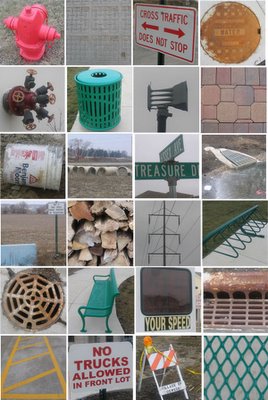Over the past few months, I have been searching everywhere for the best books in the area of visual communication and information design. Some of the books are either out-of-print (sadly) or too expensive (have to draw the line sometimes -- $125 is not easy to swallow for a book). Libraries seem to have few books that are just right. I've seen several good lists along the way, and have been able to pick up some of the books here and there as the meager Visual Congruence budget would allow. If you have other books to suggest, please share them. If you are a publisher and would like to send a copy of a book that I can review in this blog, I'm game. These are in no particular order, and some could probably fit just as well in other categories. Enjoy...
Image & Style ReferencesRunning Press Cyclopedia
Meet Mr. Product: The Art of the Advertising Character,
Warren Dotz, Masud HusainUltimate Visual Dictionary
Color Index,
Jim Krause
Design Basics Index,
Jim Krause
The Universal Phrase Book,
Sterling Publishing
Future Perfect,
Jim Heimann (for Taschen Icons)
The Order of Things,
Barbara Ann KipferInspiration = Ideas,
Petrula VrontikasUnderstanding Healthcare,
Richard Saul WurmanHow To: Absolutely Everything You Need to Know Fully Illustrated,
Jennifer McKnight-Trontz
Marshall Brain's How Stuff Works,
Marshall BrainMarshall Brain's More How Stuff Works,
Marshall BrainThe Firefly Five Language Visual Dictionary,
Corbeil & ArchambaultInformation Graphics
Information Graphics: A Comprehensive Illustrated Reference,
Robert HarrisDigital Diagrams,
Trevor BoundfordWordless Diagrams,
Nigel HolmesVisual Thesaurus,
Goveia & HatmakerInformation Graphics: Innovative Solutions in Contemporary Design,
Peter Wildbur & Michael BurkeLingua Grafica: Major Reference Work for Image Language,
Mutabor
Lingua Universalis: Global Wordless Understanding,
Mutabor
Signs & Symbols
(Pepin Press)
Packaging and Design Formats
How to Fold
(Pepin Press)
Structual Package Designs
(Pepin Press)
Mail It!
(Pepin Press)
Information Design
Information Design Desk Reference,
Christine Sevilla
Visual Function: An Introduction to Information Design,
Paul Mijksenaar
Visual Literacy,
Judith WildeVisual Literacy,
Marcia WeaverInformation Dashboard Design,
Stephen FewVisual Intelligence: How We Create What We See,
Donald Hoffman
Graphic Discovery,
Howard WainerUniversal Principles of Design,
Lidwell, Holden, ButlerGeometry of Design,
Kimberly Elam
Show Me the Numbers,
Stephen Few
Tufte (he gets his own category)
Visual Explanations,
Edward Tufte
Envisioning Information,
Edward TufteThe Visual Display of Quantitative Information,
Edward Tufte
Very Cool Miscellany
Reinventing the Wheel,
Jessica HelfandGraphic Storytelling & Visual Narrative,
Will EisnerDrawing from Life: The Journal as Art,
Jennifer New
You are Here: Personal Geographies & Other Maps of the Imagination,
Katharine HarmonHow to Lie with Maps,
Mark MonmonierArt/Design: Communicating Visually,
Gilbert Clark and Enid Zimmerman
The Leader's Guide to Storytelling,
Stephen DenningPaper Prototyping,
Carolyn SnyderDeBono's Thinking Course,
Edward deBonoSigns: Lettering in the Environment,
Baines & DixonVisualization / MappingMapping Inner Space: Learning and Teaching Visual Mapping,
Nancy MarguliesRapid Problem Solving with PostIt Notes,
David StrakerThe Mind Map Book,
Tony BuzanMindManager for Dummies,
Hugh Cameron, Roger VoightMind Mpas at Work,
Tony BuzanDraw! A Visual Approach to Thinking, Learning & Communicating,
Hanks & BellistonRapid Viz,
Hanks & Belliston
The Big Book of Flip Charts,
Robert William LucasStrategy Mapping,
Kaplan & NortonThinking Visually,
Malcolm CraigTypography
Thinking with Type: A Critical Guide,
Ellen LuptonGrid Systems: Principles of Organizing Type,
Kimberly Elam


